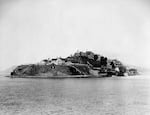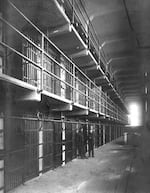
This image shows Alcatraz Island when it was a military prison, circa 1900.
Courtesy of the National Park Service
On May 28, 1875, a Modoc man from Southern Oregon died at Alcatraz. He was one of the first Native Americans sentenced to the island prison.
Alcatraz, known as “the Rock,” is a popular San Francisco tourist attraction with an infamous history as a maximum-security prison. Today, it is part of the Golden Gate National Recreation Area, though President Donald Trump recently said he would reopen the island as a federal prison.

This image, circa 1900, shows a cell block at Alcatraz when it was a military prison.
Courtesy of the National Park Service
‘The Rock’ as a military prison
Long before visitors toured Alcatraz or famous inmates like Al Capone arrived to serve time, the small island acted as the first fortress and military prison on the West Coast. In 1861, it housed both civilians and Southern sympathizers during the Civil War.
According to the National Park Service, by 1873, the government sent the first Native Americans to the island prison, including two men from the Modoc tribe of Southern Oregon and Northern California.
Following Northern California’s Modoc War of 1872-73, a military commission sentenced six Modoc men to death for murder in violation of the laws of war. It was the only time the Army charged Native Americans with that crime.
However, just before the execution, President Ulysses S. Grant commuted the sentences of Barncho and Sloluck to life at Alcatraz. Four other men — Captain Jack, Schonchin John, Black Jim and Boston Charley — were executed at Fort Klamath, Oregon.

This composition of Modoc prisoner photographs from 1873 shows Captain Jack, Schonchin John, Boston Charley and Black Jim at Fort Klamath, Oregon.
Courtesy of that National Archives
Some of the first Native Americans at Alcatraz
In November 1873, the Stockton Independent reported that the two men “Are now confined at Alcatraz. Their present occupation is cleaning bricks.”
Barncho died at Alcatraz of tuberculosis on May 28, 1875, and was buried at Fort McDowell on nearby Angel Island. Later, his remains were moved to the Golden Gate National Cemetery.
Sloluck remained on Alcatraz until 1878, the longest stay of any Native American prisoner on the island.
Eventually, the military transferred Sloluck to Fort Leavenworth and finally allowed him to join his family in Indian Territory in what is now Oklahoma.
Over the years, Alcatraz housed numerous Native prisoners. A man called Paiute Tom arrived on June 5, 1873, from Camp McDermit, Nevada. He was shot and killed by guards two days later.
Hopis imprisoned for refusing boarding schools
In 1895, the U.S. government sent 19 Hopi men to the island for refusing to send their children to federal boarding schools for forced assimilation into mainstream society.
According to the National Park Service website, “In August, the nineteen were returned to Hopi after promises to obey all orders were extracted. But reports back to Washington indicate the people of Hopi continued to resist the policies of Washington.”

This image from 1895 shows Hopi prisoners at Alcatraz military prison.
Courtesy of the National Park Service
Indian occupation
The government finally closed the prison in 1963, classifying it as abandoned surplus federal land. In 1969, a group of Native American protesters claimed it as Indian Land. The occupation lasted until June 1971, when the government removed them.

This image from 1975, shows the Alcatraz water tower with Indian occupation graffiti.
Courtesy of the National Park Service

Behind the Scenes: Producer’s Note
The story of the Hopi prisoners sent to Alcatraz will be included in the upcoming Oregon Experience documentary “Uncovering Boarding Schools, stories of resistance and resilience.”
I first learned about the Native American history of Alcatraz while researching and producing the Oregon Experience documentary “The Modoc War.” I was surprised to find some rare documents held at the University of California, Berkley, titled “Notes on the Modoc with a vocabulary of the language, as spoken by Sloluck, a prisoner of Alcatraz.”
The bulk of the papers are a dictionary of the Modoc language, but the first few pages describe Sloluck as “Apparently about thirty years of age. He was low in stature but well-proportioned.” The notes go on to describe a long-healed scar on Sloluck’s face and that “(He) wore an amiable and mild expression, and when he became excited or much interested during our interview, they (sic) had an appearance of great vivacity and intelligence.”
There are no known images of Sloluck, but this description helps give us a few clues as to who he was as a person — still “amiable” and “interested” despite enduring imprisonment in the cold, damp cells of Alcatraz.
